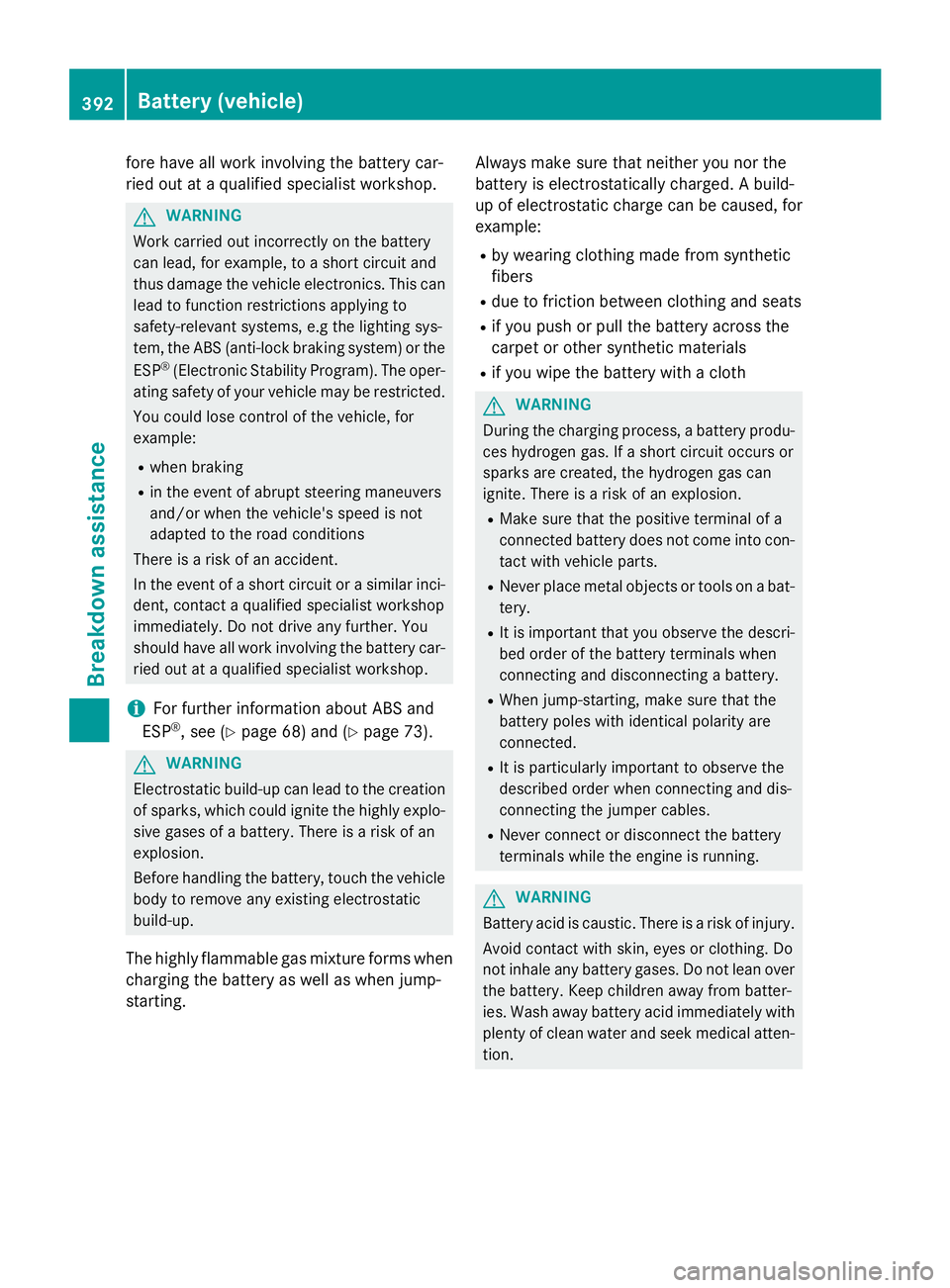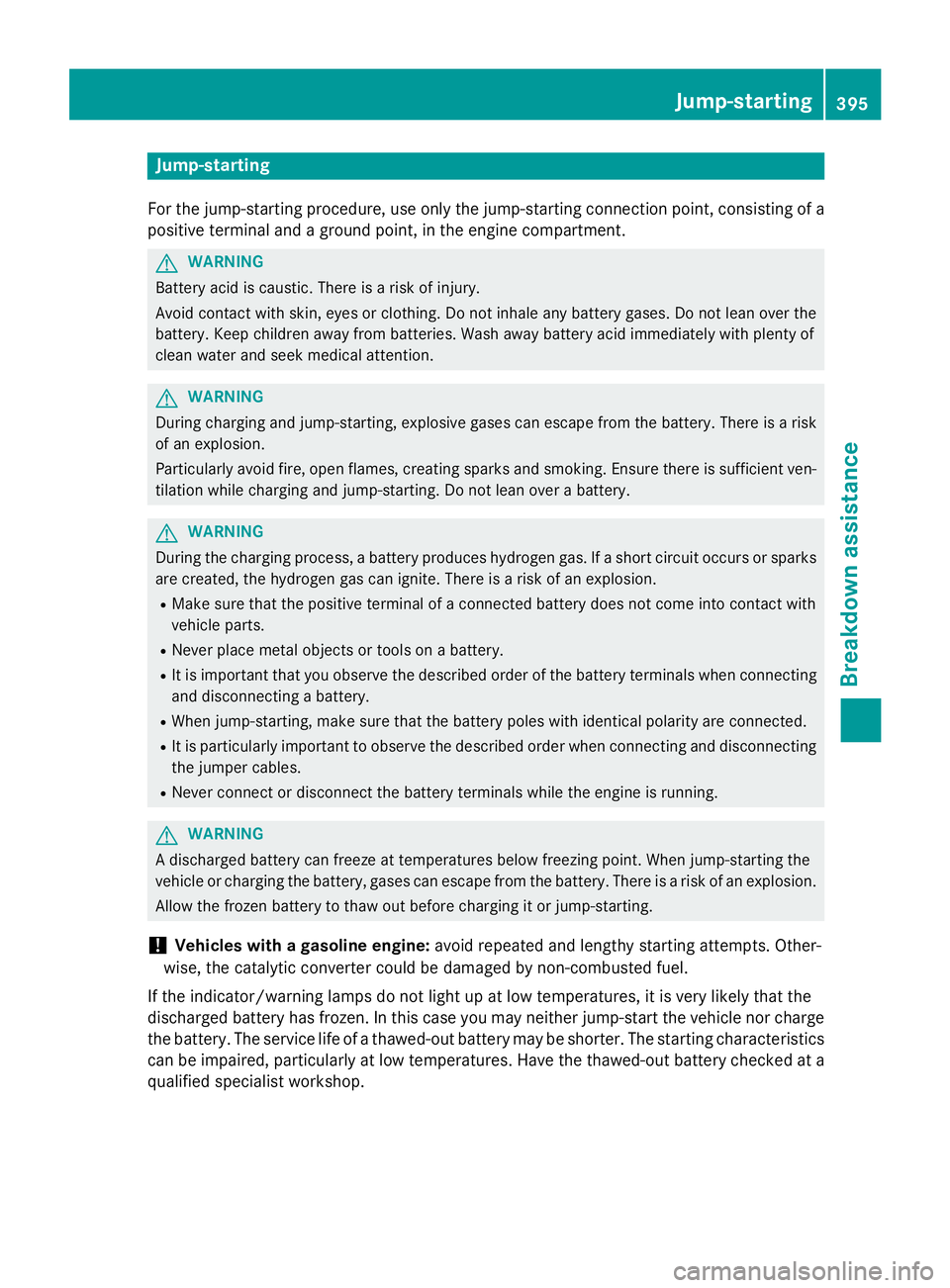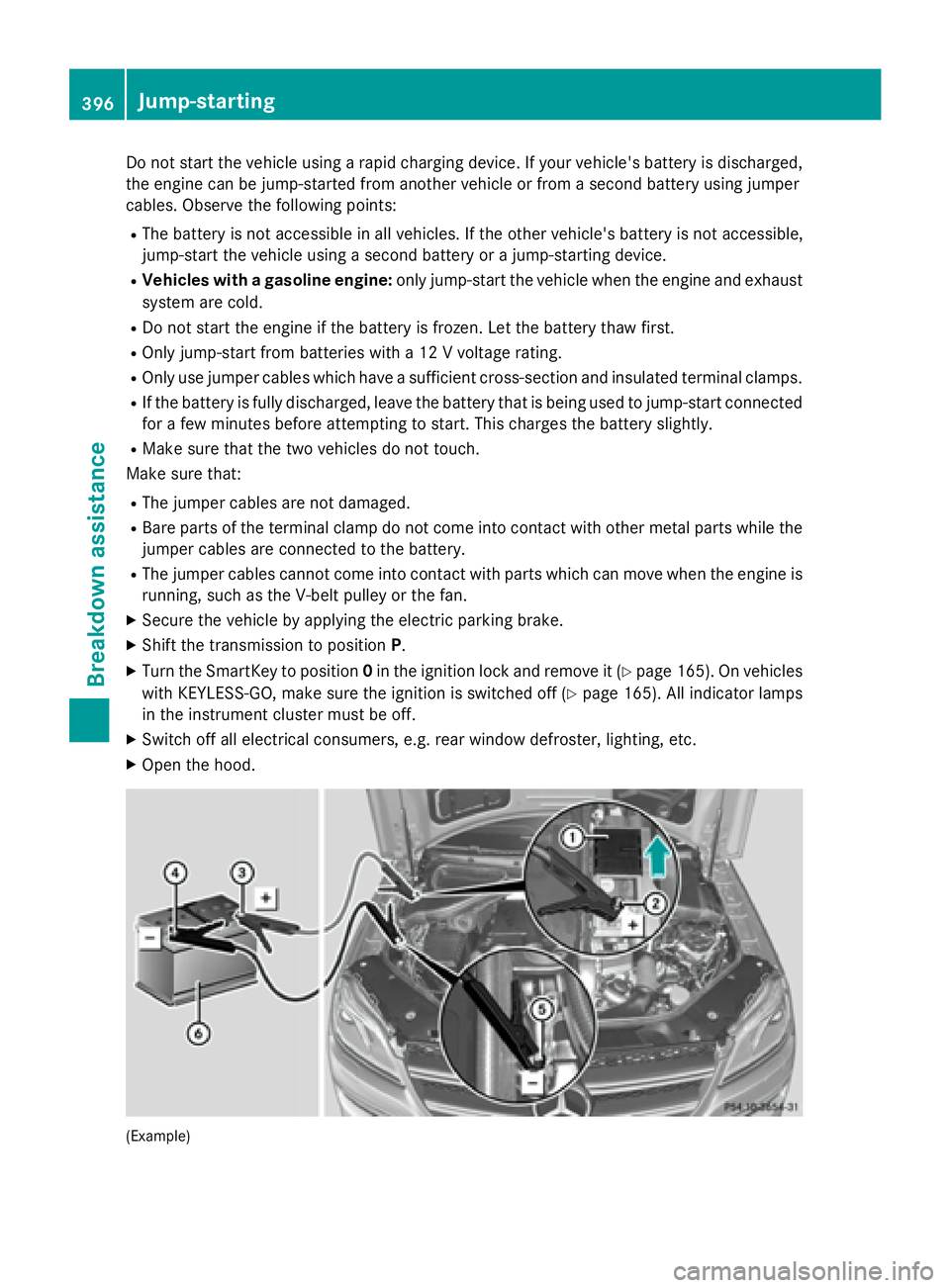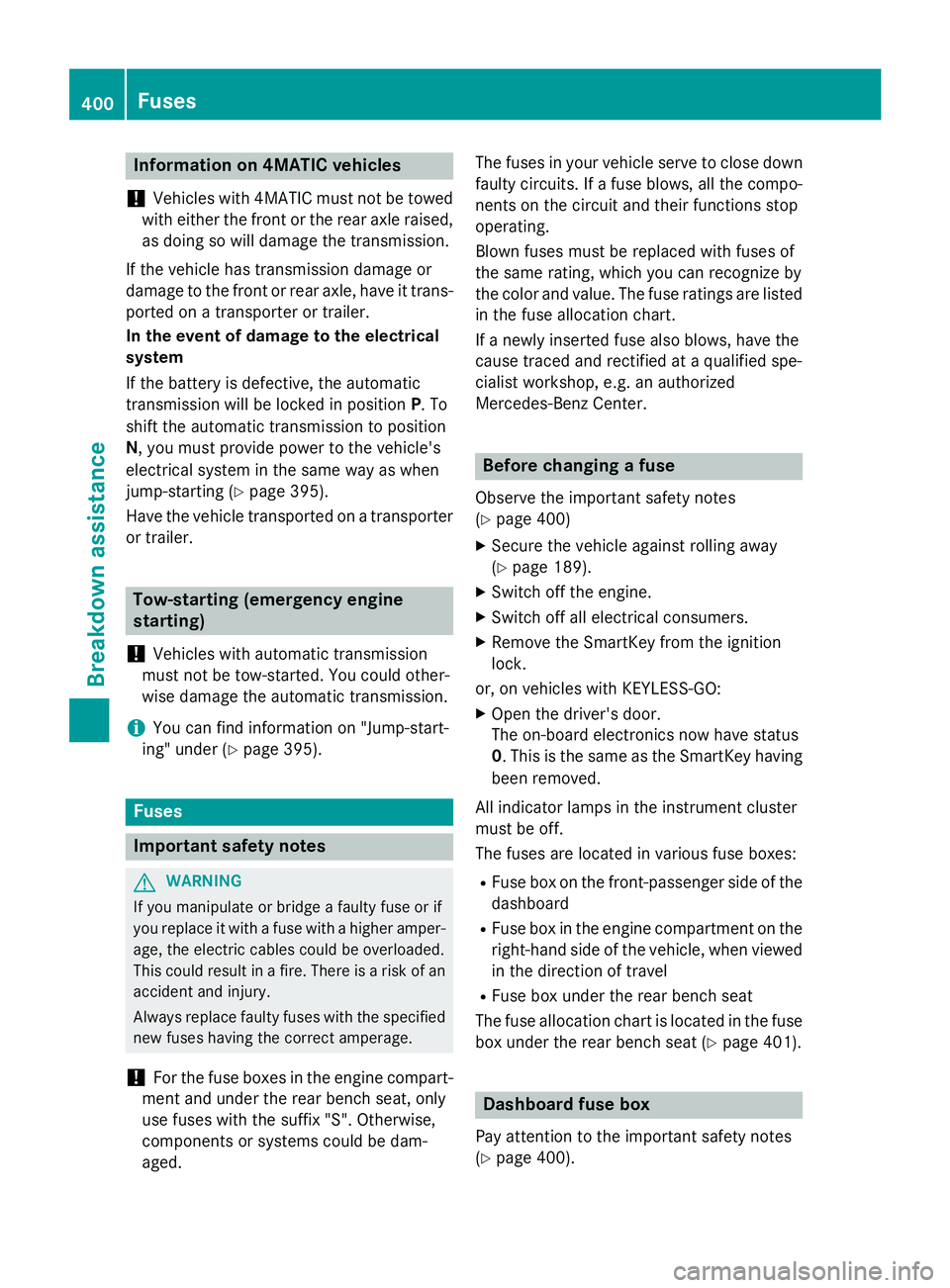jump cable MERCEDES-BENZ GL 2016 Owners Manual
[x] Cancel search | Manufacturer: MERCEDES-BENZ, Model Year: 2016, Model line: GL, Model: MERCEDES-BENZ GL 2016Pages: 462, PDF Size: 12.66 MB
Page 394 of 462

fore have all work involving the battery car-
ried out at a qualified specialist workshop.
G WARNING
Work carried out incorrectly on the battery
can lead, for example, to a short circuit and
thus damage the vehicle electronics. This can
lead to function restrictions applying to
safety-relevant systems, e.g the lighting sys-
tem, the ABS (anti-lock braking system) or the
ESP ®
(Electronic Stability Program). The oper-
ating safety of your vehicle may be restricted.
You could lose control of the vehicle, for
example: R
when braking R
in the event of abrupt steering maneuvers
and/or when the vehicle's speed is not
adapted to the road conditions
There is a risk of an accident.
In the event of a short circuit or a similar inci-
dent, contact a qualified specialist workshop
immediately. Do not drive any further. You
should have all work involving the battery car-
ried out at a qualified specialist workshop.
i For further information about ABS and
ESP ®
, see ( Y
page 68) and ( Y
page 73).
G WARNING
Electrostatic build-up can lead to the creation
of sparks, which could ignite the highly explo-
sive gases of a battery. There is a risk of an
explosion.
Before handling the battery, touch the vehicle
body to remove any existing electrostatic
build-up.
The highly flammable gas mixture forms when
charging the battery as well as when jump-
starting. Always make sure that neither you nor the
battery is electrostatically charged. A build-
up of electrostatic charge can be caused, for
example: R
by wearing clothing made from synthetic
fibers R
due to friction between clothing and seats R
if you push or pull the battery across the
carpet or other synthetic materials R
if you wipe the battery with a cloth
G WARNING
During the charging process, a battery produ-
ces hydrogen gas. If a short circuit occurs or
sparks are created, the hydrogen gas can
ignite. There is a risk of an explosion. R
Make sure that the positive terminal of a
connected battery does not come into con-
tact with vehicle parts. R
Never place metal objects or tools on a bat-
tery. R
It is important that you observe the descri-
bed order of the battery terminals when
connecting and disconnecting a battery. R
When jump-starting, make sure that the
battery poles with identical polarity are
connected. R
It is particularly important to observe the
described order when connecting and dis-
connecting the jumper cables. R
Never connect or disconnect the battery
terminals while the engine is running.
G WARNING
Battery acid is caustic. There is a risk of injury.
Avoid contact with skin, eyes or clothing. Do
not inhale any battery gases. Do not lean over
the battery. Keep children away from batter-
ies. Wash away battery acid immediately with
plenty of clean water and seek medical atten-
tion.392
Battery (vehicle)
Breakdown assistance
Page 397 of 462

Jump-starting For the jump-starting procedure, use only the jump-starting connection point, consisting of a
positive terminal and a ground point, in the engine compartment.
G WARNING
Battery acid is caustic. There is a risk of injury.
Avoid contact with skin, eyes or clothing. Do not inhale any battery gases. Do not lean over the
battery. Keep children away from batteries. Wash away battery acid immediately with plenty of
clean water and seek medical attention.
G WARNING
During charging and jump-starting, explosive gases can escape from the battery. There is a risk
of an explosion.
Particularly avoid fire, open flames, creating sparks and smoking. Ensure there is sufficient ven-
tilation while charging and jump-starting. Do not lean over a battery.
G WARNING
During the charging process, a battery produces hydrogen gas. If a short circuit occurs or sparks
are created, the hydrogen gas can ignite. There is a risk of an explosion. R
Make sure that the positive terminal of a connected battery does not come into contact with
vehicle parts. R
Never place metal objects or tools on a battery. R
It is important that you observe the described order of the battery terminals when connecting
and disconnecting a battery. R
When jump-starting, make sure that the battery poles with identical polarity are connected. R
It is particularly important to observe the described order when connecting and disconnecting
the jumper cables. R
Never connect or disconnect the battery terminals while the engine is running.
G WARNING
A discharged battery can freeze at temperatures below freezing point. When jump-starting the
vehicle or charging the battery, gases can escape from the battery. There is a risk of an explosion.
Allow the frozen battery to thaw out before charging it or jump-starting.
! Vehicles with a gasoline engine: avoid repeated and lengthy starting attempts. Other-
wise, the catalytic converter could be damaged by non-combusted fuel.
If the indicator/warning lamps do not light up at low temperatures, it is very likely that the
discharged battery has frozen. In this case you may neither jump-start the vehicle nor charge
the battery. The service life of a thawed-out battery may be shorter. The starting characteristics
can be impaired, particularly at low temperatures. Have the thawed-out battery checked at a
qualified specialist workshop. Jump-starting 395
Breakdown assistance Z
Page 398 of 462

Do not start the vehicle using a rapid charging device. If your vehicle's battery is discharged,
the engine can be jump-started from another vehicle or from a second battery using jumper
cables. Observe the following points: R
The battery is not accessible in all vehicles. If the other vehicle's battery is not accessible,
jump-start the vehicle using a second battery or a jump-starting device. R
Vehicles with a gasoline engine: only jump-start the vehicle when the engine and exhaust
system are cold. R
Do not start the engine if the battery is frozen. Let the battery thaw first. R
Only jump-start from batteries with a 12 V voltage rating. R
Only use jumper cables which have a sufficient cross-section and insulated terminal clamps. R
If the battery is fully discharged, leave the battery that is being used to jump-start connected
for a few minutes before attempting to start. This charges the battery slightly. R
Make sure that the two vehicles do not touch.
Make sure that: R
The jumper cables are not damaged. R
Bare parts of the terminal clamp do not come into contact with other metal parts while the
jumper cables are connected to the battery. R
The jumper cables cannot come into contact with parts which can move when the engine is
running, such as the V-belt pulley or the fan. X
Secure the vehicle by applying the electric parking brake. X
Shift the transmission to position P .X
Turn the SmartKey to position 0 in the ignition lock and remove it ( Y
page 165). On vehicles
with KEYLESS-GO, make sure the ignition is switched off ( Y
page 165). All indicator lamps
in the instrument cluster must be off. X
Switch off all electrical consumers, e.g. rear window defroster, lighting, etc. X
Open the hood.
(Example)396
Jump-starting
Breakdown assistance
Page 402 of 462

Information on 4MATIC vehicles
! Vehicles wit h 4MATIC must not be towed
wit h either the front or the rear axle raised,
as doin g so will damage the transmission.
If the vehicle has transmission damage or
damage to the front or rear axle, have it trans-
ported on a transporter or trailer.
In the event of damage to the elect ri cal
system
If the battery is defective, the automat ic
transmission will be locked in position P . To
shift the automat ic transmission to position
N , you must pro vide power to the vehicle's
electrical system in the same way as when
jum p- starting ( Y
page 395).
Have the vehicle transported on a transporter
or trailer.
Tow-starting (emergency engine
starting)
! Vehicles wit h automat ic transmission
must not be tow-starte d. You could other-
wise damage the automat ic transmission.
i You can find information on "Jump-start-
ing" under ( Y
page 395).
Fuses
Important safety notes
G WARNIN G
If you manipulat e or bridge a fault y fus e or if
you replace it wit h a fus e wit h a higher amper-
age, th e electric cables could be overloaded.
This could result in a fire. Ther e is a ris k of an
acciden t and injury.
Always replace fault y fuses wit h th e specifie d
ne w fuses having th e correc t amperage .
! For the fuse boxes in the engine compart-
ment and under the rear bench seat, on ly
use fuses wit h the suffix "S". Otherwise,
components or systems could be dam-
aged. The fuses in your vehicle ser ve to close down
faulty circuits. If a fuse blows, all the compo-
nents on the circuit and their functions stop
operating.
Blo wn fuses must be replaced wit h fuses of
the same rating, which you can recogn iz e by
the color and value. The fuse ratings are list ed
in the fuse allocation chart.
If a newly inserted fuse also blows, have the
cause traced and rectified at a qualif ied spe-
cialist worksho p, e.g. an authorized
Mercedes-Benz Center.
Before changing a fuse Observe the important safety notes
( Y
page 400) X
Se cure the vehicle against rol lin g away
( Y
page 189). X
Swi tch off the engine. X
Swi tch off all electrical consumers. X
Remo ve the Sm artKey from the ign it ion
lock.
or, on vehicles wit h KEYLE SS ‑ GO:X
Open the driver's door.
The on-board electronics now have status
0 . This is the same as the Sm artKey having
been remove d.
All indicator lamps in the instrument cluster
must be off.
The fuses are located in various fuse boxes:R
Fuse box on the front-passenger side of the
dashboard R
Fuse box in the engine compartment on the
right-hand side of the vehicle, when view ed
in the direction of travel R
Fuse box under the rear bench seat
The fuse allocation chart is located in the fuse
box under the rear bench seat ( Y
page 401).
Dashboard fuse box
Pay attention to the important safety notes
( Y
page 400).400
Fuses
Breakdown assistance